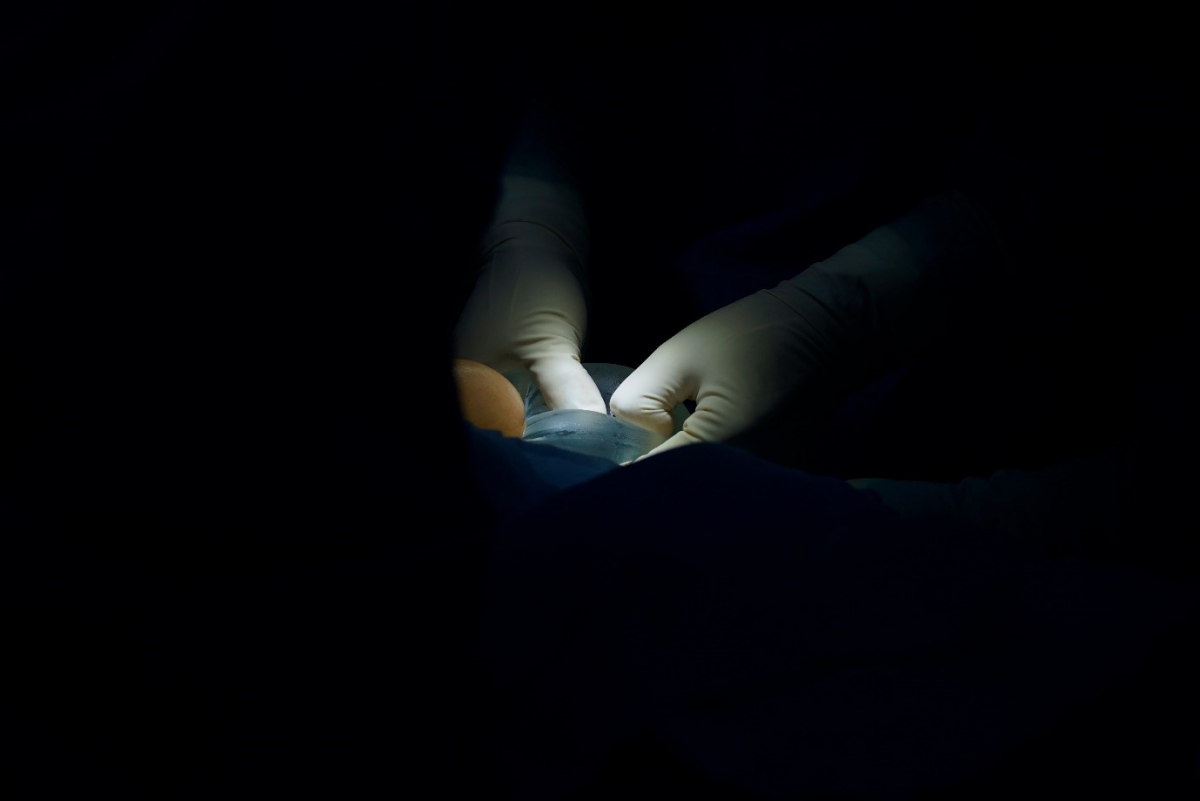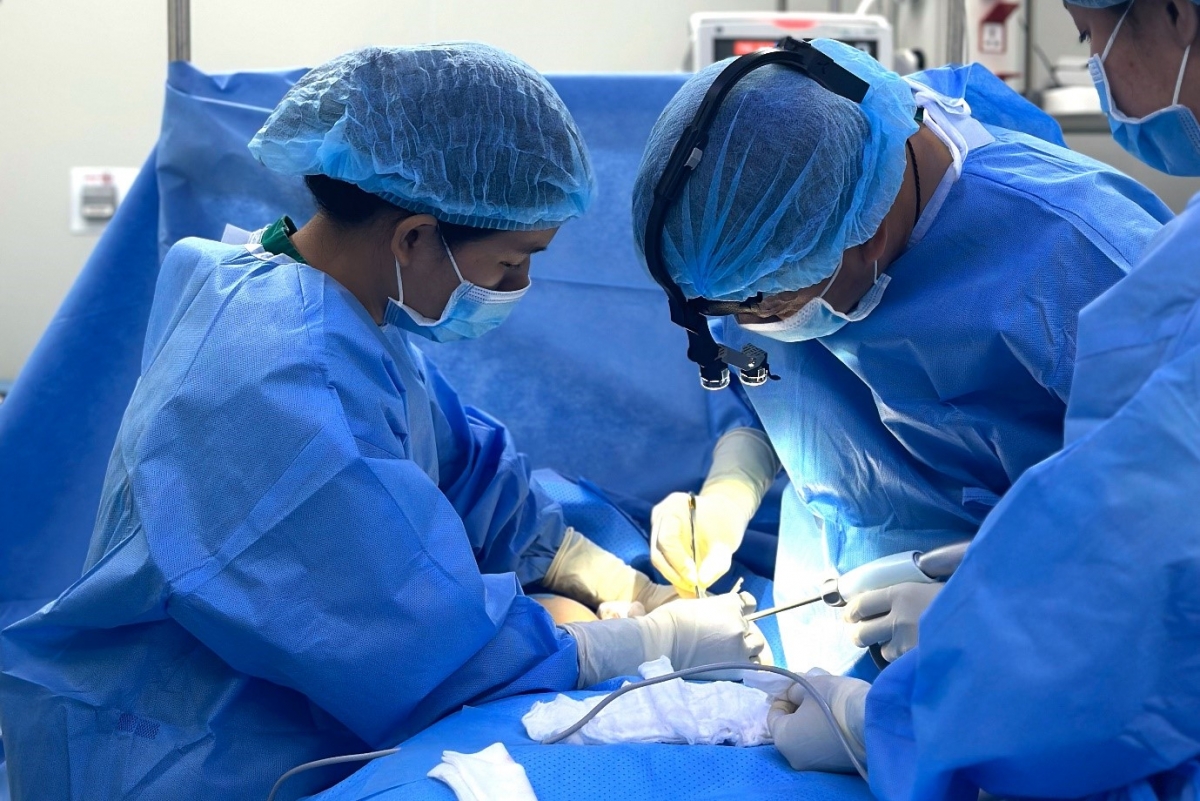Breast implant adjustment surgery: removal, pocket adjustment, and new implant placement
VOV.VN - The demand for implant removal and breast size adjustments post-augmentation is on the rise, particularly among overseas Vietnamese clients seeking a more natural appearance.
Below is a case study of a typical breast implant adjustment surgery involving removal, pocket adjustment, and new implant placement for an overseas Vietnamese client after two prior augmentation surgeries.
Ms. T. Tam, 37 years old, returned from the USA. She is 1.63m tall, weighs 48 kg, and has undergone two previous breast surgeries. She now seeks implant removal, improved breast softness, and a reduction in implant size.
First Implant Placement in 2022: She opted for breast implants to address sagging. However, after surgery, the implants were primarily positioned in the upper pole, while the breast tissue and glands remained in the lower pole. The sagging persisted as it had before the implants, leaving her dissatisfied with the aesthetic outcome. This prompted her decision to undergo a second surgery.
Second Surgery in October 2023: She chose the “lollipop” I-shaped mastopexy to correct sagging while retaining the implants. Currently, her breasts exhibit widened scars, firmness, and uneven inframammary folds. She now wishes to enhance softness, reduce implant size, and achieve a more natural breast contour, as her current appearance looks somewhat artificial.
Step 1: Pre-Surgical Consultation with Dr. Ho Cao Vu
- Scars from the previous I-shaped incision cannot be corrected.
- Adjustment of the left inframammary fold and skin excision to balance nipple-to-fold distance.
- Implant size reduction based on client preferences.
- Clinical assessment indicates possible capsular contracture or double capsule formation (client reported increased firmness while lying down).
- Symmastia observed.
- Uneven inframammary folds, with the left side lower than the right.
Step 2: Implant Removal Surgery Using the Ultrasonic Surgical Scalpel
● Right Breast: The intact 275cc implant was removed. The implant pocket was narrow, with insufficient upper pole space, creating pressure that displaced the implant to the lower pole and inner quarter. Capsular contracture was observed in the outer pole. The Ultrasonic surgical scalpel was used to excise the capsule, expand the pocket in the upper pole and outer border, and excise subcutaneous tissue and skin to adjust the inframammary fold.
● Left Breast: The intact 275cc implant was removed. The narrow pocket exerted pressure on the implant, causing folds, and the left inframammary fold was lower than the right. The Ultrasonic surgical scalpel was used to expand the pocket and suture the inframammary fold to match the new implant size.
Step 3: Discharged after 8–10 hours, with no pain relievers or antibiotics required post-surgery. Cytological examination was performed on the excised fibrous tissue.
Many clients have previously undergone breast augmentation using Blunt Dissection method, which often caused significant post-operative pain and required prolonged use of pain relievers and antibiotics. These experiences have created fear and hesitation when considering implant removal surgeries.
After learning about the Ultrasonic surgical scalpel method for implant removal—which minimizes post-operative pain, requires no drainage, and eliminates the need for pain relievers or antibiotics (for standard implant replacement cases)—many clients have returned to Vietnam for implant replacement while addressing breast aesthetics, softness, and scar issues.
Below is a sharing from Dr. Ho Cao Vu regarding important considerations for implant removal and implant size reduction surgeries.
Textured or smooth implants
For women who have had breast implants for more than 5 years, it is crucial to check the following details: the implant warranty card, brand, material (textured or smooth gel implants), implant size (diameter and projection), warranty period, and whether the implant is included in the removal list issued by reputable scientific and medical organizations worldwide. A specialized breast MRI should be performed to evaluate any conditions related to breast tissue and assess the implant's status, such as folding, rupture, or abnormal thickness of the implant pocket. If the implant is recommended for removal to prevent potential health risks, it should be replaced with certified safe implant options.
Implant removal using a point dissection method
The blunt dissection technique for breast augmentation, performed through a transaxillary incision with electrocautery, often fails to provide precise lower pole shaping using the dual-plane technique or to create an accurately defined implant pocket compared to a point dissection method. As a result, many patients with implants placed several years ago experience complications such as implant folding, insufficient pocket space, breast firmness (double capsule formation), uneven breast contours (upper vs. lower pole, inner vs. outer pole), and asymmetrical inframammary folds. For patients deciding to remove and replace implants, it is recommended to use a point dissection method with a new-generation Ultrasonic surgical scalpel. This method ensures precise pocket creation and minimizes post-surgical pain, eliminating the need for pain relievers or antibiotics post-surgery.
Assessing Conditions and Reshaping the Implant Pocket
In cases where implants have been in place for many years, anatomical structures often change. It requires an experienced surgeon to evaluate the following factors:
- Determining the width or narrowness of the old implant pocket.
- Reshaping the implant pocket to fit the size of the new implant (for wide pockets, suturing is needed; for narrow pockets, a new pocket must be created).
- Evaluating the size and projection of the old implants.
- Selecting the size and projection of new implants based on the client’s preferences and current anatomical conditions.
- Checking for abnormalities in the pocket after implant removal (e.g., inflammation, abnormal masses, thickness irregularities).
- Examining ribcage structure. For clients with previous implants, it is often challenging to assess ribcage conditions (e.g., protrusion, depression, or irregularities). After implant removal, the surgeon will evaluate and select an appropriate implant size.
- Skin elasticity changes after implants have been in place, so when reducing implant size, it is crucial to evaluate the skin’s elasticity to select an appropriate implant size.
- Performing cytological examination on abnormal fibrous tissue.
Advantages of the New-Generation Ultrasonic Surgical Scalpel in Implant Removal Surgery
Dr. Ho Cao Vu shared: “The new-generation Ultrasonic surgical scalpel operates using a weld-cut-seal mechanism, creating secure hemostasis and effectively preventing fluid leakage during surgery. It also ensures a dry surgical pocket, facilitating easier implant placement without the need for drainage. Traditional electrocautery tools only have cut-and-seal functions, which are less effective at controlling bleeding and fluid leakage, often necessitating drainage during and after surgery and prolonging operating time. Additionally, the Ultrasonic surgical scalpel’s intelligent heat control prevents tissue damage and thermal burns, which are common limitations of traditional electrocautery tools.”
As a result, clients undergoing implant removal with the Ultrasonic surgical scalpel can be discharged after 8–10 hours without requiring additional pain relievers or antibiotics. This method is highly favored by overseas Vietnamese clients for its ability to shorten recovery time and minimize post-operative discomfort.
Dr. Ho Cao Vu emphasized, “Breast implant removal cases performed with the new-generation Ultrasonic surgical scalpel, combined with laryngeal mask anesthesia, allow clients to be discharged fully healthy within 8–10 hours, as per the regulations of general hospitals. Furthermore, immediately after wound closure, clients undergo preventative scar treatment based on protocols developed by experts with over 40 years of experience, ensuring the most aesthetic surgical scars.”
For over a decade, Dr. Vu has applied the Ultrasonic surgical scalpel in breast augmentation, implant removal and replacement, and abdominoplasty surgeries, offering numerous advantages. In 2021, Dr. Vu filed for exclusive trademark rights for "Harmo 5K," and on January 25, 2024, he was officially granted ownership of this trademark.
The "Harmo 5K" no-pain breast augmentation method is now highly regarded for meeting the following criteria: no pain, no bleeding, no fluid leakage, no medication, and no downtime.




